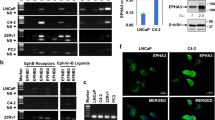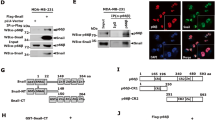Abstract
Hoxc8 is a homeobox gene family member, which is essential for growth and differentiation. Mgl1, a mouse homologue of the Drosophila tumor suppressor gene lgl, was previously identified as a possible target of Hoxc8. However, the biological effects and underlying molecular mechanism of Hoxc8 regulation on Mgl1 has not been fully established. The endogenous expression patterns of Hoxc8 were inversely correlated with those of Mgl1 in different types of cells and tissues. Here we showed that Hoxc8 overexpression downregulated the Mgl1 mRNA expression. Characterization of the ∼2 kb Mgl1 promoter region revealed that the upstream sequence contains several putative Hox core binding sites and chromatin immunoprecipitation assay confirmed that Hoxc8 directly binds to the 5′ upstream region of Mgl1. The promoter activity of this region was diminished by Hoxc8 expression but resumed by knockdown of Hoxc8 using siRNA against Hoxc8. Functional study of Mgl1 in C3H10T1/2 cells revealed a significant reduction in cell adhesion upon expression of Hoxc8. Taken together, our data suggest that Hoxc8 downregulates Mgl1 expression via direct binding to the promoter region, which in turn reduces cell adhesion and concomitant cell migration.
Similar content being viewed by others
References
Alami, Y., Castronovo, V., Belotti, D., Flagiello, D., and Clausse, N. (1999). HOXC5 and HOXC8 expression are selectively turned on in human cervical cancer cells compared to normal keratinocytes. Biochem. Biophys. Res. Commun. 257, 738–745.
Awgulewitsch, A., and Jacobs, D. (1990). Differential expression of Hox 3.1 protein in subregions of the embryonic and adult spinal cord. Development 108, 411–420.
Breier, G., Dressler, G.R., and Gruss, P. (1988). Primary structure and developmental expression pattern of Hox 3.1, a member of the murine Hox 3 homeobox gene cluster. EMBO J. 7, 1329–1336.
Chen, K.N., Gu, Z.D., Ke, Y., Li, J.Y., Shi, X.T., and Xu, G.W. (2005). Expression of 11 Hox genes is deregulated in esophageal squamous cell carcinoma. Clin. Cancer Res. 11, 1044–1049.
Chung, H.J., Lee, J.Y., Deocaris, C.C., Min, H., Kim, S.H., and Kim, M.H. (2010). Mouse homologue of the Schizophrenia susceptibility gene ZNF804A as a target of Hoxc8. J. Biomed. Biotechnol. 2010, 231708.
De Lorenzo, C., Mechler, B.M., and Bryant, P.J. (1999). What is Drosophila telling us about cancer? Cancer Metastasis Rev. 18, 295–311.
Grifoni, D., Garoia, F., Schimanski, C.C., Schmitz, G., Laurenti, E., Galle, P.R., Pession, A., Cavicchi, S., and Strand, D. (2004). The human protein Hugl-1 substitutes for Drosophila lethal giant larvae tumour suppressor function in vivo. Oncogene 23, 8688–8694.
Kang, M., Bok, J., Deocaris, C.C., Park, H.W., and Kim, M.H. (2010). Hoxc8 represses BMP-induced expression of Smad6. Mol. Cells 29, 29–33.
Kim, Y.S., Song, J., Kim, Y., Kim, I.O., Kang, I., and Baek, K.H. (2003). Functional and expression analyses of mgl-1, a mouse orthologue of lethal giant larvae recessive oncogene. Int. J. Oncol. 23, 1515–1519.
Klezovitch, O., Fernandez, T.E., Tapscott, S.J., and Vasioukhin, V. (2004). Loss of cell polarity causes severe brain dysplasia in Lgl1 knockout mice. Genes Dev. 18, 559–571.
Kuphal, S., Wallner, S., Schimanski, C.C., Bataille, F., Hofer, P., Strand, S., Strand, D., and Bosserhoff, A.K. (2006). Expression of Hugl-1 is strongly reduced in malignant melanoma. Oncogene 25, 103–110.
Kwon, Y., Ko, J.H., Kim, B.-G., and Kim, M.H. (2003). Analysis of plausible downstream target genes of Hoxc8 in F9 teratocarcinoma cells. Mol. Biol. Rep. 30, 141–148.
Kwon, Y., Shin, J., Park, H.W., and Kim, M.H. (2005). Dynamic expression pattern of Hoxc8 during mouse early embryogenesis. Anat. Rec. A Discov. Mol. Cell. Evol. Biol. 283, 187–192.
Lee, G.S., Kim, B.S., Sheih, J.H., and Moore, M. (2008). Forced expression of HoxB4 enhanced hematopoietic differentiation by human embryonic stem cells. Mol. Cells 25, 487–493.
Lei, H., Wang, H., Juan, A.H., and Ruddle, F.H. (2005). The identification of Hoxc8 target genes. Proc. Natl. Acad. Sci. USA 102, 2420–2424.
Lei, H., Juan, A.H., Kim, M.S., and Ruddle, F.H. (2006). Identification of a Hoxc8-regulated transcriptional network in mouse embryo fibroblast cells. Proc. Natl. Acad. Sci. USA 103, 10305–10309.
Lei, H., Juan, A.H., Kim, M.S., and Ruddle, F.H. (2007). Mouse Naked Cuticle 2 (mNkd2) as a direct transcriptional target of Hoxc8 in vivo. J. Exp. Zool. 307A, 1–6.
Le Mouellic, H., Condamine, H., and Brulet, P. (1988). Pattern of transcription of the homeo gene Hox-3.1 in the mouse embryo. Genes Dev. 2, 125–135.
Miller, G.J., Miller, H.L., van Bokhoven, A., Lambert, J.R., Werahera, P.N., Schirripa, O., Lucia, M.S., and Nordeen, S.K. (2003). Aberrant HOXC expression accompanies the malignant phenotype in human prostate. Cancer Res. 63, 5879–5888.
Min, H., Lee, J.Y., Bok, J., Chung, H.J., and Kim, M.H. (2010). Proliferating cell nuclear antigen (Pcna) as a direct downstream target gene of Hoxc8. Biochem. Biophys. Res. Commun. 392, 543–547.
Morgan, R. (2006). Hox genes: a contimuation of embryonic patterning? Trends Genet. 22, 67–69.
Pearson, J.C., Lemons, D., and McGinnis, W. (2005). Modulating Hox gene functions during animal body patterning. Nat. Rev. Genet. 6, 893–904.
Schimanski, C.C., Schmitz, G., Kashyap, A., Bosserhoff, A.K., Bataille, F., Schäfer, S.C., Lehr, H.A., Berger, M.R., Galle, P.R., Strand, S., et al. (2005). Reduced expression of Hugl-1, the human homologue of Drosophila tumour suppressor gene lgl, contributes to progression of colorectal cancer. Oncogene 24, 3100–3109.
Shashikant, C.S., and Ruddle, F.H. (1996). Combinations of closely situated cis-acting elements determine tissue-specific patterns and anterior extent of early Hoxc8 expression. Proc. Natl. Acad. Sci. USA 93, 12364–12369.
Takahashi, Y., Hamada, J., Murakawa, K., Takada, M., Tada, M., Nogami, I., Hayashi, N., Nakamori, S., Monden, M., Miyamoto, M., et al (2004). Expression profiles of 39 HOX genes in normal human adult organs and anaplastic thyroid cancer cell lines by quantitative real-time RT-PCR system. Exp. Cell Res. 293, 144–153.
Tomotsune, D., Shoji, H., Wakamatsu, Y., Kondoh, H., and Takahashi, N. (1993). A mouse homologue of the Drosophila tumoursuppressor gene l(2)gl controlled by Hox-C8 in vivo. Nature 365, 69–72.
Vasiokhin, V. (2006). Lethal giant puzzle of Lgl. Dev. Neurosci. 28, 13–24.
Yamamoto, M., Takai, D., Yamamoto, F., and Yamamoto, F. (2003). Comprehensive expression profiling of highly homologous 39 hox genes in 26 different human adult tissues by the modified systematic multiplex RT-pCR method reveals tissue-specific expression pattern that suggests an important role of chromosomal structure in the regulation of hox gene expression in adult tissues. Gene Exp. 11, 199–210.
Author information
Authors and Affiliations
Corresponding author
About this article
Cite this article
Ruthala, K., Gadi, J., Lee, JY. et al. Hoxc8 downregulates Mgl1 tumor suppressor gene expression and reduces its concomitant function on cell adhesion. Mol Cells 32, 273–279 (2011). https://doi.org/10.1007/s10059-011-0069-8
Received:
Revised:
Accepted:
Published:
Issue Date:
DOI: https://doi.org/10.1007/s10059-011-0069-8




